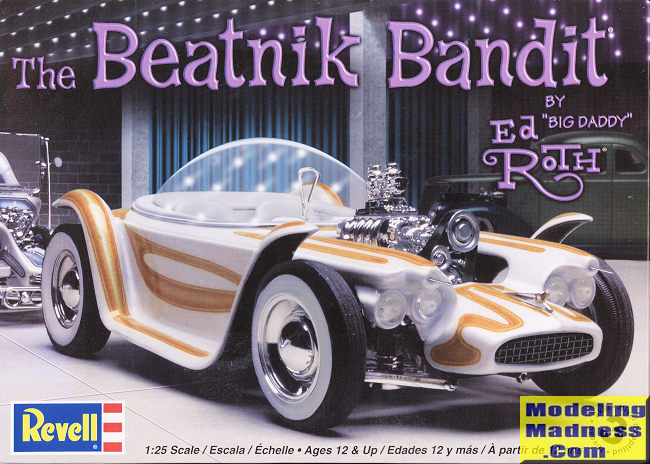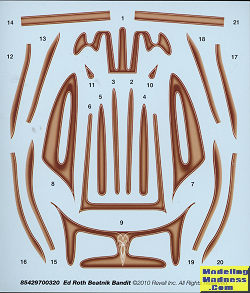
Revell 1/25 Beatnik Bandit
| KIT #: | 4297 |
| PRICE: | $21.00 when new |
| DECALS: | One option |
| REVIEWER: | Scott Van Aken |
| NOTES: |
2010 reissue |

| HISTORY |
The car originally appeared as a sketch in a project for Rod & Custom magazine called "The Grapes of Roth". This early design, featuring a tall T-type roof, was drawn by Joe Henning without much input from Roth. There are at least two stories for the origin of the car's name. One is that Roth approached Henning with the idea for the car and asked him "What am I going to call it?". Henning replied "You've got the Outlaw. Why not call this one the Beatnik Bandit?" Another version is that Roth read a news story about a bank robber nicknamed "the Beatnik Bandit" and decided to adopt the label for his car.
When Roth began building the Bandit both the design and car went through a series of changes, including the addition of the bubble top that was inspired by the glass of the DiDia 150. At first Roth tried to adapt a canopy salvaged from a B-36 bomber to the car but was unsuccessful, so a custom plexiglas canopy was made. Roth claimed that he produced the part himself in a pizza oven by blowing the plastic sheet up like a balloon, but it is believed that it was actually produced by Acry Plastics in Los Angeles, who had produced similar parts for Ron Aguirre.
Construction of the car consumed 2,000 lb (907.2 kg) of plaster, 42 yd (38.4 m) of fiberglass cloth, and 50 US gal (189.3 l) of resin. Much of the work preparing the body was done by Doug "Dirty Doug" Kinney. Many have speculated as to whether Roth made a mold of the body. Pictures in a magazine article seem to hint at the existence of one but no such molds have ever been found. The car was painted at Larry Watson's Watson's House of Style, where Roth traded the paint work for a supply of Rat Fink T-shirts.
The Bandit was featured on the cover of the May 1961 edition of Car Craft magazine. It was also the subject of an article titled “Bandit at Large” in the July 1961 issue of Rod & Custom magazine. Retrospectives of the car appeared in the 1991 issue of Rod & Custom and the March 2002 issue of Custom Rodder.
Roth trailered the Bandit around the US to various car shows, towing it with a Cadillac hearse that he lived out of. At shows Roth used a remote control that plugged into the Bandit on a long cord to remotely start the engine, turn the wheels and raise and lower the canopy. Roth sold both the Beatnik Bandit and the Outlaw to Bob Larivee, who continued to show the cars until around 1963. Larivee traded both cars back to Roth in exchange for the Mysterion. Roth then leased the Bandit to Ray Farhner who had the car painted a metallic green. Jim Brucker bought the car from Roth for $50 in 1970 and displayed it in his Movieland Cars of the Stars museum. Harrah's Automobile Collection eventually acquired all of Brucker's Roth cars, including the Bandit. In 1985 the car was restored to its original condition and since then has been on permanent display at the National Automobile Museum in Reno, Nevada.
| THE KIT |
The kit was originally released in 1963 and this is when I was first aware of it. I tried to build one back then but discovered that my skills were not sufficiently advanced for a kit like this. Thanks to working parts, much parts breakage occurred. Revell car kits of the era were known for its working bits and also for a fair amount of fragility as hinges were not up to the machinations of young teens. Working bits in this one are steering, rotating wheels and the canopy which can be opened or closed.
 The engine is
quite detailed, consisting of a lower block, oil pan, upper piston housings,
heads and valve covers. The blower assembly and valley cover are six parts.
There are also coolant lines that go to the radiator. The car's chassis is built
up with separate side rails and cross members. Attached to these are the front
and rear suspensions. As mentioned, the steering is designed to work and one
attaches the plastic stub axles to the brake drums before attaching the wheels.
The engine is
quite detailed, consisting of a lower block, oil pan, upper piston housings,
heads and valve covers. The blower assembly and valley cover are six parts.
There are also coolant lines that go to the radiator. The car's chassis is built
up with separate side rails and cross members. Attached to these are the front
and rear suspensions. As mentioned, the steering is designed to work and one
attaches the plastic stub axles to the brake drums before attaching the wheels.
Interior is built up on the floor pan/fenders part and includes interior side panels, two seats, a rear panel and the control stick. There are no pedals. Finally, one builds up the upper body that includes the rear panel, lights and grille opening. Like most cars, painting should be done on the fly. Everything aside from a few suspension bits and the cockpit floor are in pearl white. The decals are quite usable, though a bit on the thick side and consist of all the striping. Instructions are standard Revell USA fare and are quite well done.
| CONCLUSIONS |
These older show cars are popular among a certain segment of modelers and this is one that is probably more recognizable than most. It will be a fairly fussy build, but the end result will be a very nice model.
| REFERENCES |
https://en.wikipedia.org/wiki/Beatnik_Bandit
If you would like your product reviewed fairly and fairly quickly, please contact the editor or see other details in the Note to Contributors.
Back to the Main Page Back to the Review Index Page Back to the Previews Index Page